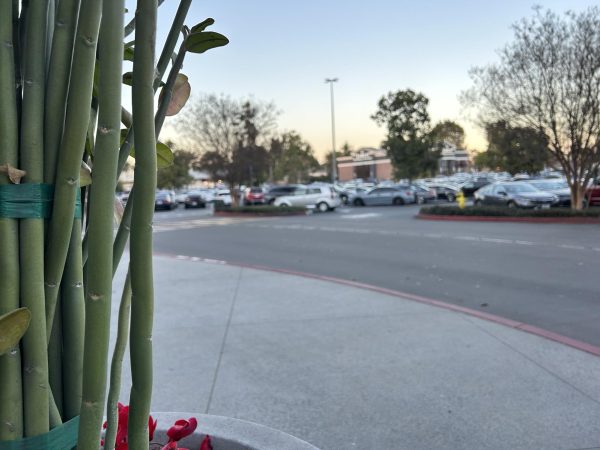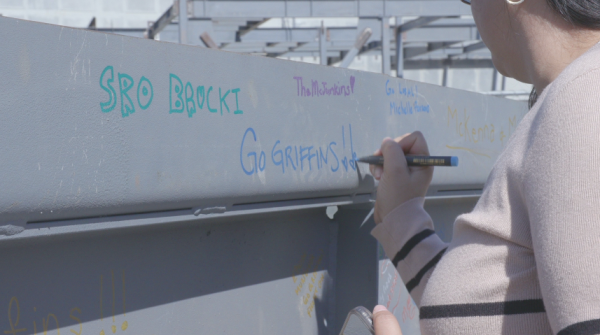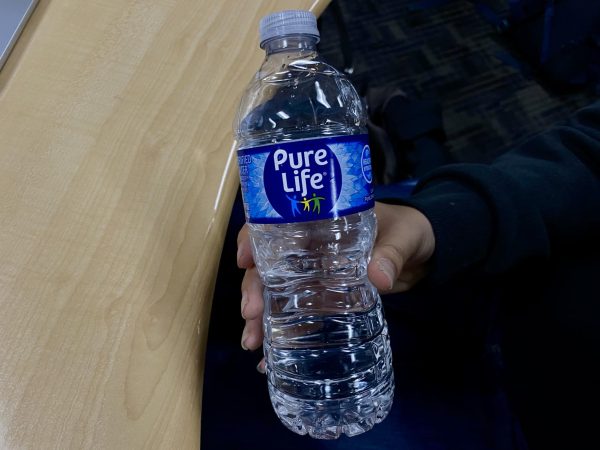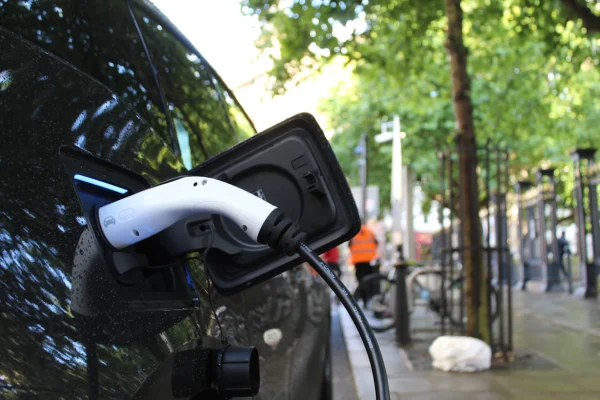Heat wave, energy crisis, climate change: What’s next?
California’s heat wave pushes state energy grid to the brink.
The sun beats down on Los Al’s new three story building.
LOS ALAMITOS, CA — Last week, Southern Californians felt the grueling heat wave that raged across the state. Many residents got alerts on their phones warning against excessive energy use. That got people thinking: What exactly caused the prolonged heat? What is the relationship between the heat and the electricity that powers my house? And how can I or the community as a whole stop this from happening again? The answer lies in heat domes, and there are a myriad of ways to mitigate their worst effects.
What went wrong?
For the past few weeks, many have wondered what the main cause of the heatwave was. According to experts, heat domes are the most likely cause. A heat dome is an area where hot air from the ocean gets suspended for a prolonged period of time. Heat domes are generally caused by high atmospheric pressures forming an invisible dome over land. Mrs. Lauren Helm, a Los Alamitos High School chemistry and AP Environmental Science teacher, shared the specifics of heat domes, “They are more likely to happen during La Niña conditions, and we are on year three of La Niña, which is extremely rare.” The resulting dome traps heat, and makes a traditional heat wave last for up to two weeks.
“Imagine a Tupperware lid on our atmosphere. We have this high pressure lid sitting over us that doesn’t allow the heat to move up and out,” Mrs. Helm said. “Normally hot air rises up, and that’s what creates things like wind.”
One big cause of heat waves is climate change, the resulting shift in the planet’s climate due to increased concentrations of carbon dioxide in the atmosphere. “Carbon dioxide and methane are molecules that are extremely good at retaining heat energy in their bonds,” Mrs. Helm explained. “[Because of this,] climate change…is actually causing changes to more than just individual weather events. Now we’re getting frequent days of extreme weather across the planet.”
Heat domes are not just uncomfortable, they are also harmful to the environment. The domes’ higher temperatures tend to last longer, which increases chances of wildfires, a phenomenon that is incredibly dangerous for us, local wildlife, and the environment.
In addition to the heat dome, California just narrowly avoided a major energy crisis. Cellphone users received an alert on Tuesday, Sept. 6, 2022 that urged California residents to conserve energy due to high temperatures straining the state energy grids. The heat caused energy transmission lines to strain, meaning that lines were losing a large sum of the electricity they were trying to transmit. Additionally, the heat caused a wide increase in air conditioning use among California residents.
“A lot of energy systems are built around having a consistent flow of energy in and people taking energy out,” Mrs. Helm explained. “When you have these extreme heat waves, and everyone turns on their air conditioning, turns on all their fans, and [makes] a bigger draw on the grid, the input of energy can’t match the output that people are drawing.”
How do we fix it?
Averting climate change related disasters and energy crises can be a daunting task. For some, these challenges are overwhelming and discourage them from participating in energy and carbon reduction activities. However, even small actions can go a long way. Mr. Tim Jones, a Los Alamitos High School chemistry and physics teacher, commented on facing climate change in an interview.
Saving Energy
Energy conservation is one of the most consequential ways to avert climate change related disasters and energy crises. Mr. Jones commented that even simple actions such as making sure to turn off lights and shutting down computers that are not being used can make a difference; many of which young people can take part in.
Furthermore, Mrs. Helm shared several energy saving methods that families can do to cool down their households. One recommendation for students is to discuss with their family about setting the thermostat to a higher but livable temperature.
“The general recommendation is between 76 and 78 degrees for your air conditioner. Your house isn’t going to get extremely hot,” Mrs. Helm said. “Picking a livable but comfortable temperature like 78 helps reduce some of the drain on the grid.”
Opening windows at night can also alleviate strain on the grid. Using the cooler air from the evening and night is an effective, yet environmentally friendly substitute for air conditioning. In the hotter hours of the day, between 11 a.m. and 2 p.m., closing windows and drawing blinds insulates houses.
Additionally, there are other unique methods to cooling your property. Mrs. Helm suggested creating a swamp cooler.
“You can take a fan, and you can put a wet blanket in front of it so that the air drawn through it gets cooled by water’s high heat capacity. Water takes much more energy to heat up than air, so when you put a wet towel in front of your fan… that water is going to absorb a lot of that heat energy, and the air that comes out has lost its heat to the water.”
Mitigating the worst effects climate change
When tackling climate change, it’s important for everyone to understand what their individual carbon usage is.
“We can do input or output control,” Mrs. Helm said. “What can you do to put less in or what can you do to take more out?”
In other words, inputs are the carbon that people put into the environment and outputs are the carbon that people make an effort to take out. For example, an input would be burning fossil fuels through transportation. An output would be planting a garden to take carbon out of the atmosphere.
There are easy and difficult ways to control carbon input and output, such as being more mindful of transportation, one of the most carbon-intensive processes. Realizing the potential for alternative methods of getting individuals and products to different places can make significant reductions in carbon emissions.
Alternative modes of transportation include using hybrid or electric cars, public transport, and cycling. In a survey conducted by the Griffin Gazette about how Los Al students and staff commute, 20% of respondents answered that they walk, bike, skateboard, or take public transportation to school. 65.2% of respondents take a gas car to school, 10.4% take a hybrid car to school, and 4.4% take an electric car to school. Walking, biking, or taking public transit can do wonders to reduce carbon footprint, so if they are accessible, all of those alternatives should be taken into consideration.
Shopping, too, can factor into lowering our carbon footprints. Purchasing from local markets and distributors simplifies the logistical process and in turn lowers carbon emissions. Most produce bought from grocery stores are shipped to the United States from foreign countries. Oftentimes, these products are not directly shipped to their final destination, but are sent to distribution centers where they are then trucked to grocery stores. By buying from local markets and distributors, the logistical process is condensed, shortening the number of miles traveled per product and thus its carbon emissions.
Ethical shopping plays as big of a role as condensing logistical operations to the local and regional level. One of the largest ethical shopping movements comes from the B Corp certification process. B Corp is a non-profit that promotes ethically sourced products derived from environmentally friendly materials. These products help promote good business practices, which should inspire other companies to follow suit.
The Griffin Gazette also polled Los Al about other ways they help the environment in a survey. Several survey respondents said that they use runoff water to water their plants. Others commented that they take time out of their day to compost. One shared that they turn off faucet water when they are scrubbing dishes and only turn it back on for rinsing, another simple way to save water and help the environment. Some students shared that they participate in local beach cleanups and help pick up trash around their neighborhoods. All of these are easy ways to help the environment that can make a much greater impact than people think.
Conclusion
Although the summer is coming to a close and the heat dome is over, it is still important to be aware of carbon and energy usage. Different parts of California still face threats of heat waves everyday, and the state power grid is having trouble keeping up with the excessive energy use drawn by high temperatures.
As climate change worsens, people need to do their part in helping the environment. Although the threat of climate change can be daunting, people need to look at this situation with the seriousness it deserves. The more people there are doing their part, the more hopeful our future will become.
Your donation will support the student journalists of Los Alamitos High School. Your contribution will allow us to purchase equipment and cover our annual website hosting costs.

Alicia Tan is a senior at Los Alamitos High school and new to the journalism program. In her free time, she loves to write and play video games. In addition,...

Sean Macdonald is a 12th grader who is currently attending Los Alamitos High School. He is an aspiring civil rights lawyer, diplomat, or librarian. He...














JP • Oct 7, 2022 at 5:20 am
Very well written article with loads of important information!
kate schumacher • Sep 29, 2022 at 2:11 pm
Such an incredible piece of work! Love how this was laid out and all the possibilities made known. Great job
lfranzen • Sep 28, 2022 at 11:44 am
I appreciate that the possible solutions offered here are reasonably do-able. Your article is well-served by the quotes you chose to include. The research is easy to digest and adds to the momentum and message of the writing.
Isabella Gasper • Sep 25, 2022 at 9:29 pm
The way you two wrote this article is absolutely incredible. Great job, you did amazing!
Katie Arnoult • Sep 21, 2022 at 12:30 pm
This article is so amazing!!! I love it! Thank you Alicia and Sean for working so hard to write about this important topic!